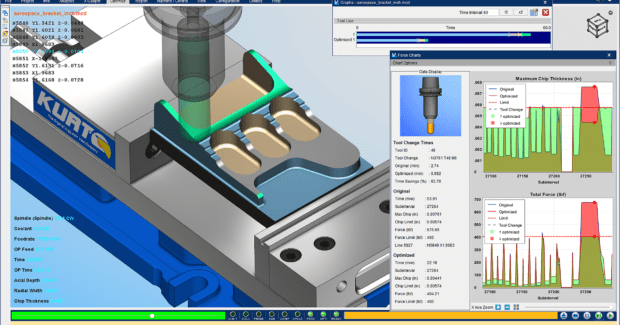Software Enhancements Raise the Bar for Process Simulation
CGTech incorporated hundreds of customer-requested improvements into Version 9.1 of its Vericut CNC software. Enhancements include advancements in graphics and display controls, streamlined controls, and new visibility options.
Posted: September 29, 2020
Vericut simulation, verification, and optimization software from CGTech (Irvine, CA) simulates all types of CNC machining, additive, and hybrid manufacturing processes. The software operates independently, but can also be integrated with leading CAM systems.
Features in the latest release, Vericut 9.1, that empower users to do more in less time include new visibility options as well as enhancements to toolpath optimization, additive manufacturing, tooling and multitool stations, measuring, and inspection/reporting.
Enhanced visibility. New visibility features have been added to the project tree and right-click convenience menus for components and models, enabling users to toggle between visible and invisible states or enable/disable 3D objects for the simulation. Quickly see unobstructed views of the cutting process and gain better access to the part by removing enclosures, models of sheet metal or shrouding, and other objects via “Invisible” or “Disable” actions.
Similar features have been added to Auto-Diff to provide more control over component visibility, such as when fixture models should appear.
X-caliper annotated images. Setup Plan is renamed Annotated Images, which now includes Inspection. Setup Plan and Inspection functionality is greatly enhanced with dimensions, notes, and tolerances for checking parts at various stages of machining. Easily create informative setup plans and inspection images stored with view layouts that are ready to print as “shop aid” documents or to appear in Vericut’s comprehensive reports.
Shanks in cutting tool assemblies. Defining shanks as separate objects from the holder and cutter enables programmers to see where these non-cutting portions of the cutter are relative to the stock workpiece, and allows more discrete control over near-miss and collision-detection properties and tolerances. Toolholder models can also be used as “Shanks.”
Streamlined optimization with artificial intelligence (AI). The Optimize Control window now fits in a single window with no tabs, and relevant features become active in subsections depending on which mode is selected. With a new Force “Learn” mode that uses artificial intelligence (AI), the software uses the simulation to automatically configure and optimize tools for increased cutting efficiency and reduced machining times.
Force charts. “Save All As” optimization settings option added to the right mouse menu when clicking on a force chart. New ability to ‘Learn From Results’ enables optimization settings for a tool or all tools that were analyzed.
Additive manufacturing. A new “Additive” default machining type enables the software to predict what system resources will be needed to additively build the as-designed part, including a starting stock build plate or model. The program can build multiple parts created by a nested build NC program, enabling additively built parts to be independently relocated or assembled for finish machining or exported. This feature is especially helpful for big area additive manufacturing (BAAM) and large scale additive manufacturing (LSAM) parts.
DXF import. The DXF reader can now read the layers within a DXF file and automatically detect CUT/NOCUT layers. Additional layers can be checked on to use as additional components.





